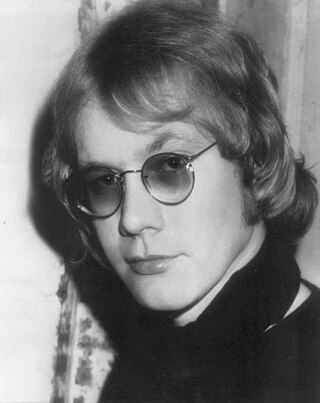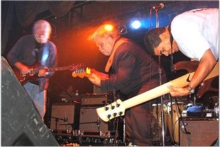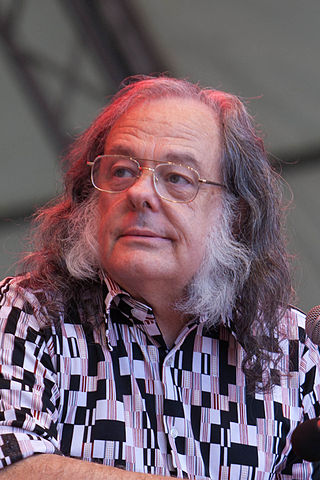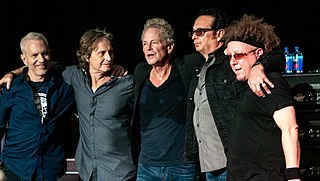
Benjamin Montmorency "Benmont" Tench III is an American musician and singer, and a founding member of Tom Petty and the Heartbreakers.

Warren William Zevon was an American rock singer, songwriter, and musician.

Col. Bruce Hampton and the Aquarium Rescue Unit is a jazz fusion group founded by Col. Bruce Hampton. The band gained popularity in the Atlanta club scene in the early 1990s and went on to tour with the first H.O.R.D.E. Tour. During their formative years, the band was composed of Bruce Hampton, Oteil Burbridge, Jimmy Herring, Jeff Sipe, Matt Mundy, and Count M'Butu. Jeff Mosier and Charlie Williams were members of the band during the early years, but left to pursue other endeavors. Although the band was never commercially successful, their combination of bluegrass, rock, Latin, blues, jazz, funk, and impeccable chops became a template for future bands.

Live Licks is a double live album by the Rolling Stones and was released in 2004. Coming six years after No Security, this ninth official Rolling Stones full-length live release captures performances from the band's year-long 2002–2003 Licks Tour in support of their career-spanning retrospective Forty Licks.

David Perry Lindley was an American musician who founded the rock band El Rayo-X and worked with many other performers including Jackson Browne, Linda Ronstadt, Ry Cooder, Bonnie Raitt, Warren Zevon, Curtis Mayfield and Dolly Parton. He mastered such a wide variety of instruments that Acoustic Guitar magazine referred to him not as a multi-instrumentalist but instead as a "maxi-instrumentalist." On stage, Lindley was known for wearing garishly colored polyester shirts with clashing pants, gaining the nickname the Prince of Polyester.

Dirty Work is the 18th British and 20th American studio album by the English rock band the Rolling Stones. It was released on 24 March 1986 on the Rolling Stones label by CBS Records, their first under their new contract with Columbia Records. Produced by Steve Lillywhite, the album was recorded during a period when relations between Mick Jagger and Keith Richards had soured considerably, according to Richards' autobiography Life.

Larry Campbell is an American multi-instrumentalist who plays many stringed instruments in genres including country, folk, blues, and rock. He is perhaps best known for his time as part of Bob Dylan's Never Ending Tour band from 1997 to 2004.

Ian Patrick McLagan was an English keyboardist, best known as a member of the rock bands Small Faces and Faces. He also collaborated with the Rolling Stones and led his own band from the late 1970s. He was inducted into the Rock and Roll Hall of Fame in 2012.

Charles Alfred Leavell is an American musician. A member of the Allman Brothers Band throughout their commercial zenith in the 1970s, he subsequently became a founding member of the band Sea Level. He has served as the principal touring keyboardist and musical director of the Rolling Stones since 1982. As a session musician, Leavell has performed on every Rolling Stones studio album released since 1983 with the exception of Bridges to Babylon (1997). He has also toured and recorded with Eric Clapton, George Harrison, David Gilmour, Gov't Mule and John Mayer.

Scott Troy Thurston is an American guitarist, keyboardist, songwriter, and session musician. He was a member of the Stooges, and of Tom Petty and the Heartbreakers, in which he sang harmony vocals and played guitar, bass, keyboards, and harmonica.

Sea Level was an American rock band from Macon, Georgia. Formed in 1976, the band was an offshoot of the Allman Brothers Band. Between 1977 and 1980, the band released five studio albums which incorporated elements of funk, blues and Latin music.

Randall Bramblett is an American musician and singer-songwriter, whose career as a solo artist, session player, and touring musician, has spanned more than three decades. He has worked with Gregg Allman, Bonnie Raitt, Goose Creek Symphony, Robbie Robertson, Elvin Bishop, Steve Winwood, Bonnie Bramlett, B.J. Thomas, Widespread Panic, Jay E. Livingston and Roger Glover. He plays keyboards, saxophones, flute, guitar, mandolin, and harmonica, and his songwriting is influenced by blues, folk, and gospel music.

A backup band or backing band is a musical ensemble that typically accompanies a single artist who is the featured performer. The situation may be a live performance or in a recording session, and the group may or may not have its own name, such as "The Heartbreakers", or "Bob Wills and his Texas Playboys" in the 1930s. Often, backup bands contain sidemen who are skilled but not known to the public; these musicians may be replaced or substituted at any time without noticeable impact on the performance.

Robin Sylvester was an English musician who was best known as a member of the American band RatDog. Although primarily a bass player, he played several instruments, including the guitar and keyboards, and did extensive arranging.
The Section were a US instrumental rock/jazz fusion band formed in the early 1970s by guitarist Danny Kortchmar, keyboardist Craig Doerge, bassist Leland Sklar, and drummer Russ Kunkel. Other musicians associated with the group include multi-instrumentalist David Lindley and guitarist Waddy Wachtel. They are best known for both studio and stage work in support of some of the best selling singer-songwriters and solo singers of that decade. Their frequent appearances on the records of artists signed to Asylum Records made them the label's de facto house band. Their close association with the singer-songwriter and soft rock genres of the 1970s also led to their alternate moniker of "The Mellow Mafia".

James Hutchinson (born January 24, 1953)is an American session bassist best known for his work with Bonnie Raitt.Though his work takes him nearly everywhere he primarily resides in Studio City, Los Angeles, CA and Haiku-Pauwela, Hawaii.

Kenneth Michael Edwards was an American singer, songwriter, bassist, guitarist, mandolinist, and session musician. He was a founding member of the Stone Poneys and Bryndle and a long-time collaborator with Linda Ronstadt and Karla Bonoff.

Use Me is an album by David Bromberg. It was released by Appleseed Recordings on July 12, 2011.

Bill Johnson is a Canadian blues guitarist, singer-songwriter and music educator. After a long career as a sideman and guitarist in the 1990s, he began touring with The Bill Johnson Band. They released their second album, Live, in 2006, which led to Johnson being nominated for Best Guitarist at the Maple Blues Awards. He self-released his third solo album, Still Blue, in 2010, which was nominated for Blues Album of the Year at the Juno Awards of 2012. Johnson continues to tour and has hosted blues workshops throughout Canada.

Brett Tuggle was an American musician who is best known for his keyboard playing with Fleetwood Mac and the David Lee Roth band.




















